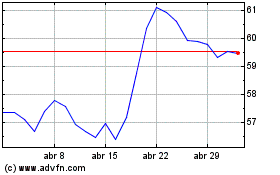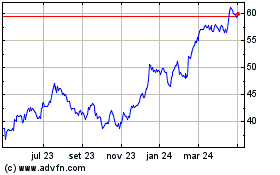The major U.S. index futures are currently pointing to a roughly
flat higher open on Friday, with stocks likely to show a lack of
direction following the substantial downturn seen over the course
of the previous session.
Traders may take a step back following the recent volatility in
the markets, which saw stocks surge on Wednesday before pulling
back sharply on Thursday.
Early trading may be impacted by reaction to a Labor Department
report showing producer prices in the U.S. increased by slightly
more than expected in the month of June.
The Labor Department said its producer price index for final
demand rose by 0.2 percent in June following a revised unchanged
reading in May.
Economists had expected producer prices to inch up by 0.1
percent compared to the 0.2 percent dip originally reported for the
previous month.
The report also said the annual rate of producer price growth
accelerated to 2.6 percent in June from an upwardly revised 2.4
percent in May.
The annual rate of producer price growth was expected to creep
up to 2.3 percent from the 2.2 percent originally reported for the
previous month.
Traders are also reacting to earnings news from several big-name
financial companies, with Wells Fargo (NYSE:WFC) moving sharply
lower in pre-market trading after reporting weaker than expected
net interest income for the second quarter.
Shares of JPMorgan Chase (NYSE:JPM) are also seeing modest
pre-market weakness even though the financial giant reported second
quarter revenues that exceeded analyst estimates.
On the other hand, shares of Citigroup (NYSE:C) are likely to
see initial strength after the company reported second quarter
results that beat expectations on both the top and bottom
lines.
Stocks showed a substantial downturn over the course of the
trading session on Thursday, with the Nasdaq and the S&P 500
pulling back sharply after reaching new record intraday highs in
early trading.
The tech-heavy Nasdaq posted a particularly steep loss on the
day, plunging 364.04 points or 2.0 percent to 18,283.41, while the
S&P 500 slumped 49.37 points or 0.9 percent to 5,584.54.
The narrower Dow, on the other hand, spent most of the day
lingering near the unchanged line before closing up 32.39 points or
0.1 percent at 39,753.85.
While optimism about the outlook for interest rates contributed
to early strength on Wall Street, buying interest waned shortly
after the start of trading.
Traders may have seen the increased confidence in a September
rate cut as already priced into the markets following Wednesday’s
rally.
The subsequent sell-off came as traders took the opportunity to
cash in on the recent strength in the markets, with some of the
biggest tech winners of the year like AI darling Nvidia
(NASDAQ:NVDA) leading the pullback.
Nonetheless, the Federal Reserve is still seen as likely to
lower rates in September after a report from the Labor Department
showing showed prices in the U.S. unexpectedly edged slightly lower
in the month of June.
The Labor Department said its consumer price index slipped by
0.1 percent in June after coming in unchanged in May. Economists
had expected consumer prices to inch up by 0.1 percent.
The unexpected dip by consumer prices came as another steep drop
by gasoline prices more than offset a continued increase in shelter
costs.
Excluding food and energy prices, core consumer prices crept up
by 0.1 percent in June after rising by 0.2 percent in May. Core
prices were expected to increase by another 0.2 percent.
The report also said the annual rate of consumer price growth
slowed to 3.0 percent in June from 3.3 percent in May. Economists
had expected the pace of price growth to decelerate to 3.1
percent.
The annual rate of core consumer price growth also slowed to 3.3
percent in June from 3.4 percent in May. The pace of growth was
expected to remain unchanged.
“This is the kind of CPI report the Fed wants to see [to] feel
more confident that inflation is headed back toward their target,”
said Bill Adams, Chief Economist for Comerica Bank. “The Fed
targets 2% inflation by the personal consumption expenditures price
index, which usually runs a little cooler than the CPI.”
He added, “The CPI report won’t be enough to convince the Fed to
cut interest rates at their decision this month, but a rate cut at
the following decision in September is quite likely.”
Semiconductor stocks moved sharply lower over the course of the
session, giving back ground following recent strength in the
sector.
The Philadelphia Semiconductor Index plunged by 3.5 percent,
pulling back off the record closing high set on Wednesday.
Software and computer hardware stocks also showed notable moves
to the downside, contributing to the steep drop by the tech-heavy
Nasdaq.
On the other hand, housing stocks saw substantial strength amid
optimism about lower interest rates, resulting in a 5.7 percent
spike by the Philadelphia Housing Sector Index.
Considerable strength also emerged among gold stocks, as
reflected by the 2.8 percent surge by the NYSE Arca Gold Bugs
Index. The strength in the sector came amid a sharp increase by the
price of the precious metal
Interest rate-sensitive commercial real estate, telecom and
utilities stocks also saw significant strength, while oil service,
transportation and networking stocks also showed strong moves to
the upside.
Wells Fargo (NYSE:WFC)
Gráfico Histórico do Ativo
De Jun 2024 até Jul 2024

Wells Fargo (NYSE:WFC)
Gráfico Histórico do Ativo
De Jul 2023 até Jul 2024
